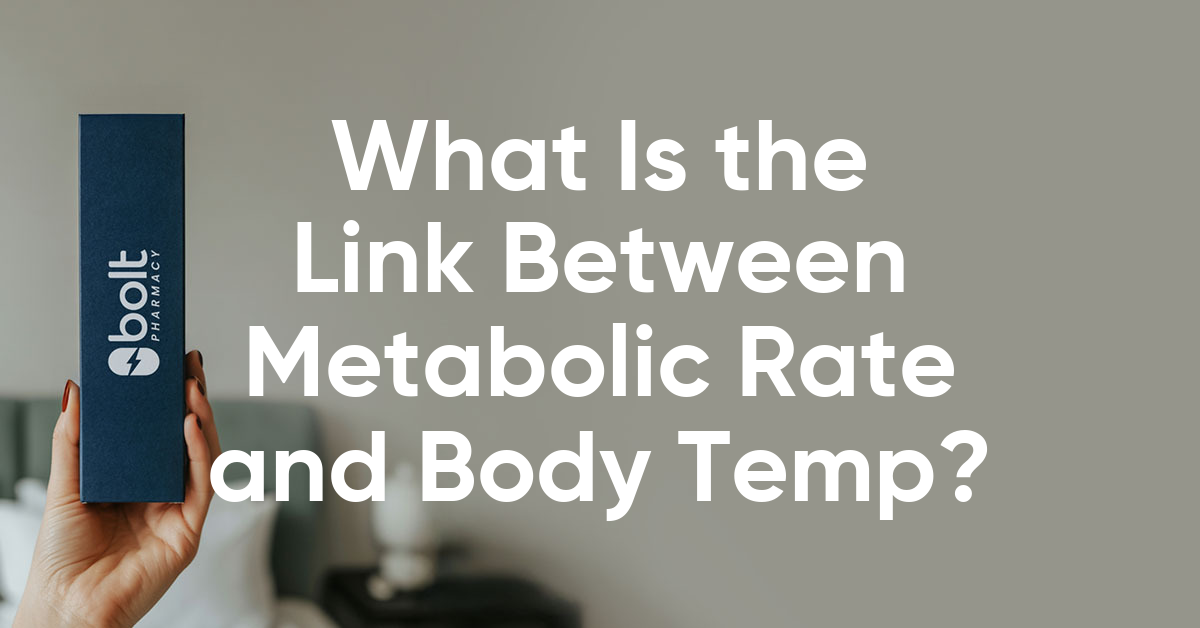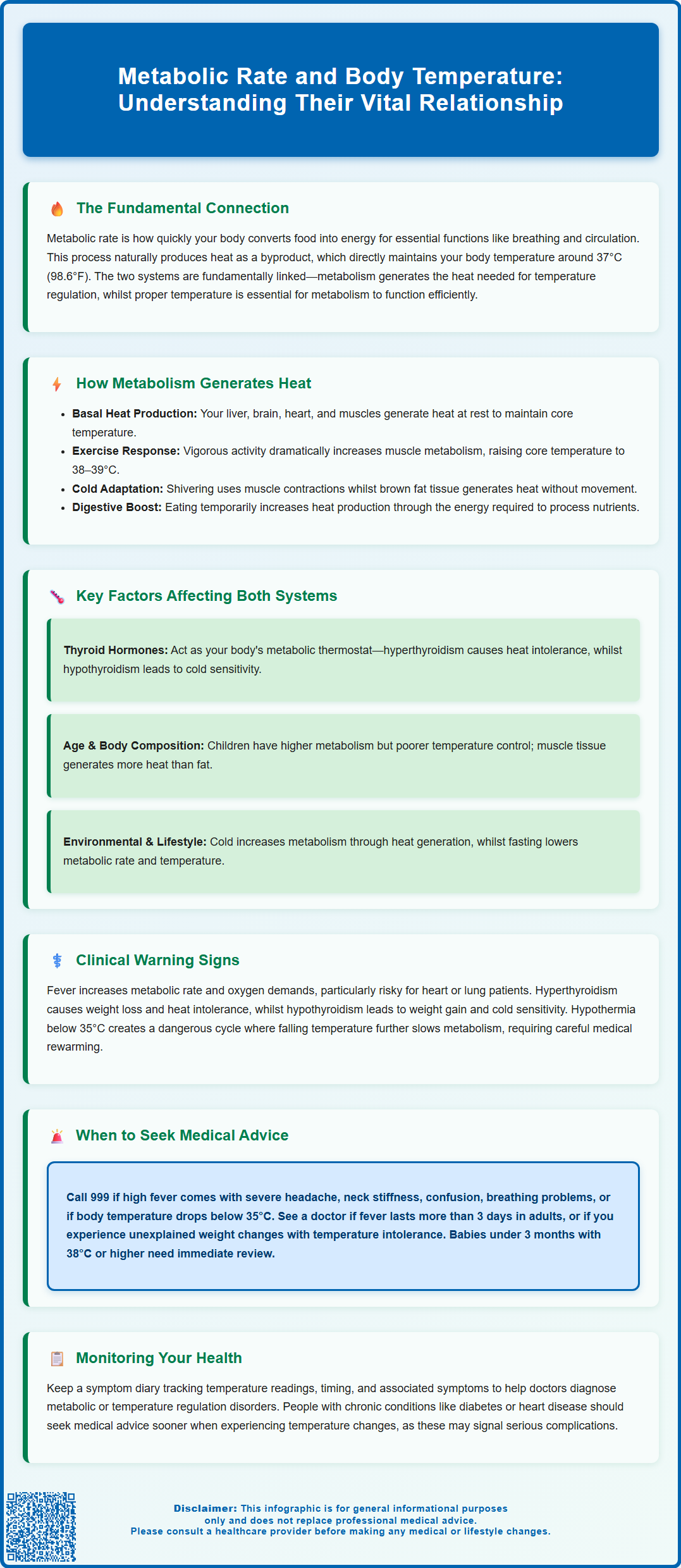Mounjaro®
Dual-agonist support that helps curb appetite, hunger, and cravings to drive substantial, sustained weight loss.
- ~22.5% average body weight loss
- Significant weight reduction
- Improves blood sugar levels
- Clinically proven weight loss

Metabolic rate and body temperature are fundamentally interconnected physiological parameters. Metabolic processes—the chemical reactions converting food into energy—inherently generate heat as a byproduct, which is essential for maintaining the body's core temperature around 37°C. This heat production isn't wasteful; it enables optimal enzyme function and cellular processes. When metabolic rate increases during exercise or illness, body temperature rises accordingly. Conversely, reduced metabolism, such as in hypothyroidism, can lower body temperature. Understanding this relationship is clinically important across numerous conditions, from thyroid disorders to fever states, providing valuable diagnostic information for healthcare professionals.
Summary: Metabolic rate directly influences body temperature because metabolic processes generate heat as a byproduct of energy conversion, which maintains core body temperature within the narrow range required for optimal cellular function.
Metabolic rate refers to the speed at which your body converts food and stored energy into usable fuel for cellular processes. This encompasses all chemical reactions occurring within cells to maintain life, including breathing, circulation, cell repair, and digestion. Measured in calories or kilojoules per unit time, metabolic rate varies considerably between individuals and fluctuates throughout the day based on activity levels, food intake, and physiological state.
Body temperature represents the balance between heat production and heat loss in the body. In humans, core body temperature is typically regulated around 37°C (98.6°F), though normal ranges span approximately 36.1–37.2°C, varying by measurement site (oral, tympanic, rectal) and time of day. This thermoregulation is controlled by the hypothalamus in the brain, which acts as the body's thermostat, constantly monitoring temperature and initiating responses to maintain homeostasis.
The relationship between these two physiological parameters is fundamentally interconnected. Metabolic processes are inherently exothermic—they generate heat as a byproduct of energy conversion. A substantial portion of the energy released during metabolism is dissipated as heat rather than being captured for cellular work. This heat production is not wasteful; it serves the essential function of maintaining body temperature within the narrow range required for optimal enzyme function and cellular processes.
Understanding this relationship is clinically relevant across numerous conditions, from thyroid disorders affecting metabolic rate to fever states where elevated temperature impacts metabolic demands. Both parameters provide valuable diagnostic information and influence treatment decisions in various medical contexts.
Metabolic processes directly generate the heat necessary to maintain body temperature. At rest, the basal metabolic rate (BMR)—the energy expended for essential functions like heartbeat, breathing, and cellular maintenance—produces sufficient heat to sustain core temperature. Organs with high metabolic activity, particularly the liver, brain, heart, and skeletal muscles, are the primary heat generators in the body at rest.
When metabolic rate increases, heat production rises proportionally. During physical exercise, skeletal muscle metabolism can increase substantially, generating heat that elevates body temperature. This is why core temperature may rise to 38–39°C during vigorous activity—a normal physiological response. The body compensates through heat-loss mechanisms including vasodilation (widening of blood vessels near the skin surface), increased sweating, and elevated respiratory rate. If you experience confusion, dizziness, or collapse during exercise, stop immediately and seek medical help, as these may indicate heat illness.
Thermogenesis—heat production specifically for temperature regulation—occurs through several mechanisms:
Shivering thermogenesis: Involuntary muscle contractions generate heat when body temperature drops
Non-shivering thermogenesis: Occurs in brown adipose tissue, particularly important in infants but also present in adults, where metabolic processes generate heat without muscle contraction
Diet-induced thermogenesis: The metabolic cost of digesting, absorbing, and processing nutrients increases heat production temporarily after eating
Conversely, when metabolic rate decreases—such as during sleep, starvation, or hypothyroidism—heat production diminishes. Without compensatory mechanisms like seeking warmth or reducing heat loss through vasoconstriction, body temperature would fall. This demonstrates the critical dependence of temperature regulation on adequate metabolic function and explains why conditions affecting metabolism often present with temperature disturbances.

Thyroid hormones represent the most significant endocrine influence on both metabolic rate and temperature regulation. Thyroxine (T4) and triiodothyronine (T3) increase cellular oxygen consumption and metabolic activity across virtually all tissues. Hyperthyroidism significantly elevates metabolic rate, causing heat intolerance, increased sweating, and occasionally mild temperature elevation. Conversely, hypothyroidism reduces metabolic rate, leading to cold intolerance and potentially lower body temperature. The thyroid essentially sets the body's metabolic 'thermostat'.
Age significantly influences this relationship. Infants and young children have higher metabolic rates relative to body size and less efficient thermoregulation, making them more vulnerable to temperature fluctuations. Elderly individuals typically experience declining metabolic rate with age and impaired thermoregulatory responses, increasing risks of both hypothermia and hyperthermia.
Body composition affects both parameters substantially. Muscle tissue is metabolically active, generating heat even at rest, whilst adipose tissue provides insulation but has lower metabolic activity. Individuals with greater muscle mass typically have higher resting metabolic rates and better heat production capacity.
Other influential factors include:
Hormonal fluctuations: Progesterone during the luteal phase of the menstrual cycle raises basal body temperature by approximately 0.3–0.5°C
Medications: Some medicines, including certain antipsychotics and anticholinergics, can impair thermoregulation. Never change medication without consulting your prescriber
Environmental temperature: Extreme cold increases metabolic rate through thermogenesis; extreme heat may slightly elevate metabolism through cooling mechanisms
Nutritional status: Prolonged caloric restriction reduces metabolic rate as an adaptive response
Circadian rhythms: Both metabolic rate and body temperature follow daily patterns, typically lowest during early morning sleep
Fever exemplifies the clinical intersection of metabolism and temperature. During infection, inflammatory mediators (pyrogens) reset the hypothalamic temperature set-point upward. The body responds by increasing metabolic rate to generate additional heat, often through shivering, until the new higher temperature is achieved. As body temperature rises, metabolic rate increases proportionally. This metabolic elevation increases oxygen consumption, cardiac output, and nutritional demands—clinically significant in patients with limited cardiorespiratory reserve or critical illness.
Thyroid disorders present characteristic patterns. Patients with hyperthyroidism may exhibit resting tachycardia, weight loss despite increased appetite, heat intolerance, and occasionally low-grade fever. Hypothyroidism manifests with fatigue, weight gain, cold intolerance, and potentially hypothermia in severe cases (myxoedema coma). NICE guidelines recommend thyroid function testing with TSH as the first-line test, with free T4 and possibly free T3 added based on TSH results and clinical suspicion.
Malignant hyperthermia represents a life-threatening condition where certain anaesthetic agents trigger uncontrolled skeletal muscle metabolism in genetically susceptible individuals. Core temperature may rise rapidly, accompanied by muscle rigidity, tachycardia, and metabolic acidosis. This medical emergency requires immediate specialist management, including dantrolene administration and aggressive cooling.
Hypothermia (core temperature <35°C) progressively impairs metabolic function. As temperature falls, enzyme activity decreases, reducing metabolic rate further—a dangerous positive feedback loop. Moderate to severe hypothermia requires careful rewarming in hospital settings, as rapid temperature changes can precipitate cardiac arrhythmias.
Sepsis disrupts normal temperature-metabolism relationships. Whilst fever is common, some patients—particularly elderly or immunocompromised individuals—develop hypothermia despite increased metabolic demands, indicating severe physiological decompensation and poor prognosis. In the UK, the National Early Warning Score 2 (NEWS2) is used to identify deteriorating patients, including those with sepsis, recognising that temperature alone is insufficient for assessment.
Seek urgent medical attention (999 or A&E) if experiencing:
High temperature with severe headache, neck stiffness, confusion, difficulty breathing, chest pain, or rash that doesn't fade under pressure
Temperature below 35°C (95°F)
Signs of heat stroke: high temperature with confusion, seizures, or loss of consciousness
Fever with severe symptoms in a child under 3 months
Contact your GP or call NHS 111 for:
Persistent fever lasting more than three days in adults or more than five days in children
Unintentional weight loss
Persistent fatigue with cold intolerance, constipation, or dry skin (possible hypothyroidism)
Heat intolerance, unexplained weight loss, tremor, or palpitations (possible hyperthyroidism)
Recurrent episodes of feeling excessively hot or cold without environmental explanation
Temperature changes following new medication initiation
For children specifically, seek medical review if:
An infant under three months has a temperature of 38°C or higher
A child aged 3–6 months has a temperature of 39°C or higher
Fever is accompanied by unusual drowsiness, reduced fluid intake, or decreased urine output
Patients with chronic conditions (diabetes, heart disease, respiratory conditions) should have lower thresholds for seeking advice, as temperature and metabolic changes may indicate decompensation. Those taking medications affecting thermoregulation (antipsychotics, anticholinergics) should be particularly vigilant during extreme weather.
If you suspect a medicine is causing temperature regulation problems, report this through the MHRA Yellow Card scheme while continuing to take your medication unless advised otherwise by a healthcare professional.
Regular monitoring of temperature patterns can provide useful information for healthcare professionals. Keeping a symptom diary noting temperature readings, timing, associated symptoms, and any triggering factors helps facilitate accurate diagnosis and appropriate management of underlying metabolic or thermoregulatory disorders.
During exercise, skeletal muscle metabolism increases substantially, generating additional heat that elevates core body temperature to 38–39°C. The body compensates through heat-loss mechanisms including vasodilation, increased sweating, and elevated respiratory rate to prevent overheating.
Thyroid hormones regulate metabolic rate and temperature. Hyperthyroidism increases metabolism, causing heat intolerance and elevated temperature, whilst hypothyroidism reduces metabolism, leading to cold intolerance and potentially lower body temperature.
Seek urgent medical attention for temperature below 35°C, high fever with severe symptoms (confusion, chest pain, difficulty breathing), or signs of heat stroke. Contact your GP for persistent fever lasting more than three days in adults or unexplained temperature regulation problems.
The health-related content published on this site is based on credible scientific sources and is periodically reviewed to ensure accuracy and relevance. Although we aim to reflect the most current medical knowledge, the material is meant for general education and awareness only.
The information on this site is not a substitute for professional medical advice. For any health concerns, please speak with a qualified medical professional. By using this information, you acknowledge responsibility for any decisions made and understand we are not liable for any consequences that may result.
Lorem ipsum dolor sit amet, consectetur adipiscing elit, sed do eiusmod tempor incididunt ut labore et dolore magna aliqua. Ut enim ad minim veniam, quis nostrud exercitation ullamco laboris nisi ut aliquip ex ea commodo consequat. Duis aute irure dolor in reprehenderit in voluptate velit esse cillum dolore eu fugiat nulla pariatur.
Block quote
Ordered list
Unordered list
Bold text
Emphasis
Superscript
Subscript